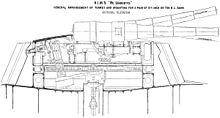This article explains terms used for the British Armed Forces' ordnance (weapons) and ammunition. The terms may have different meanings depending on its usage in another country's military.

The BL 15-inch Mark I succeeded the BL 13.5-inch Mk V naval gun. It was the first British 15-inch (380 mm) gun design and the most widely used and longest lasting of any British designs, and arguably the most successful heavy gun ever developed by the Royal Navy. It was deployed on capital ships from 1915 until 1959 and was a key Royal Navy gun in both World Wars.
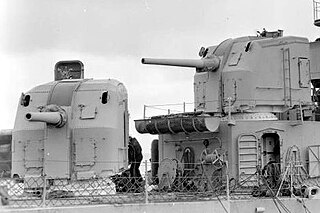
The Mark 12 5"/38-caliber gun was a United States dual-purpose naval gun, but also installed in single-purpose mounts on a handful of ships. The 38-caliber barrel was a mid-length compromise between the previous United States standard 5"/51 low-angle gun and 5"/25 anti-aircraft gun. United States naval gun terminology indicates the gun fired a projectile 5 inches (127 mm) in diameter, and the barrel was 38 calibers long. The increased barrel length provided greatly improved performance in both anti-aircraft and anti-surface roles compared to the 5"/25 gun. However, except for the barrel length and the use of semi-fixed ammunition, the 5"/38 gun was derived from the 5"/25 gun. Both weapons had power ramming, which enabled rapid fire at high angles against aircraft. The 5"/38 entered service on USS Farragut, commissioned in 1934, the first new destroyer design since the last Clemson was built in 1922. The base ring mount, which improved the effective rate of fire, entered service on USS Porter, commissioned in 1936.
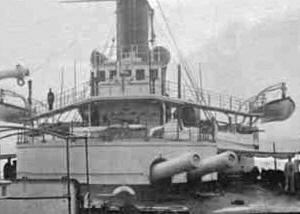
The BL 12 inch naval gun Mk I was a British rifled breech-loading naval gun of the early 1880s intended for the largest warships such as battleships and also coastal defence. It was Britain's first attempt to match the large guns being installed in rival European navies, particularly France, after Britain transitioned from rifled muzzle-loading guns to the modern rifled breech-loaders somewhat later than the European powers. Mks I - VII all had a barrel of approximately 303 inches in length and similar performance.

The BL 12-inch Mark VIII naval gun was one of the first large British rifled breech-loading naval guns designed for the higher pressures generated by the new cordite propellant of the 1890s, and Britain's first large wire-wound gun. It represented a major advance compared to previous British guns.

The BL 6-inch gun Marks II, III, IV and VI were the second and subsequent generations of British 6-inch rifled breechloading naval guns, designed by the Royal Gun Factory in the 1880s following the first 6-inch breechloader, the relatively unsuccessful BL 6-inch 80-pounder gun designed by Elswick Ordnance. They were originally designed to use the old gunpowder propellants but from the mid-1890s onwards were adapted to use the new cordite propellant. They were superseded on new warships by the QF 6-inch gun from 1891.
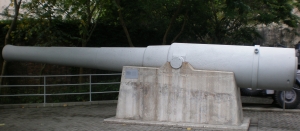
The BL 10 inch guns Mks I, II, III, IV were British rifled breechloading 32-calibre naval and coast defence guns in service from 1885.

The BL 8 inch guns Mark I to Mark VII were the first generations of British rifled breechloaders of medium-heavy calibre. They were initially designed for gunpowder propellants and were of both 25.5 and 30 calibres lengths.
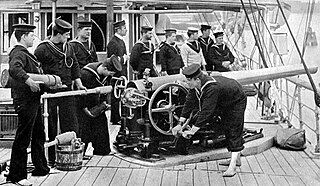
The BL 4-inch gun Mk I – Mk VI were a family of early British breech-loading 4-inch naval guns.

The BL 6 inch gun Mk V was an early Elswick Ordnance Company breech-loading naval gun originally designed to use the old gunpowder propellants. They were used for coast defence around the British Empire.

The BL 5-inch guns Mk I – Mk V were early British 5-inch rifled breechloading naval guns after it switched from rifled muzzle-loaders in the late 1870s. They were originally designed to use the old gunpowder propellants. The 5-inch calibre was soon discontinued in favour of QF 4.7-inch.

The BL 12-inch Mark XI and Mark XII gun were British breech loading (BL) naval guns of 50-calibres length mounted as primary armament on dreadnought battleships from 1910.

The RML 9-inch guns Mark I – Mark VI were large rifled muzzle-loading guns of the 1860s used as primary armament on smaller British ironclad battleships and secondary armament on larger battleships, and also ashore for coast defence. It should not be confused with the RML 9-inch Armstrong Gun, used by the Dutch navy, the Spanish Navy, and other navies.

The RML 12.5-inch guns were large rifled muzzle-loading guns designed for British battleships and were also employed for coast defence.
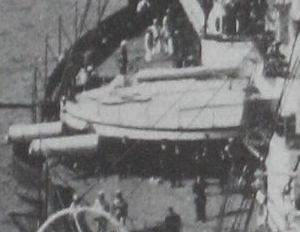
RML 16-inch 80-ton guns were large rifled muzzle-loading guns intended to give the largest British battleships parity with the large guns being mounted by Italian and French ships in the Mediterranean Sea in the 1870s.

In artillery, caliber or calibre is the internal diameter of a gun barrel, or, by extension, a relative measure of the barrel length.
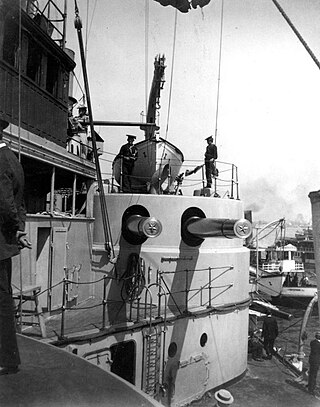
The 8"/35 caliber gun Mark 3 and Mark 4 were used for the main batteries of the United States Navy's first armored cruisers and the secondary batteries for their first battleships, the Indiana-class. The 8"/40 caliber gun Mark 5 initially armed the Pennsylvania-class armored cruisers.

The 8"/45 caliber Mark 6 gun were used for the secondary batteries of the United States Navy's last pre-dreadnought battleships and refitted in older armored cruisers main batteries.

The 6"/40 caliber gun Mark 4 were used for the secondary batteries of the United States Navy's Indiana-class and Illinois-class battleships. They were also used as the main battery on the Cincinnati-class protected cruisers.
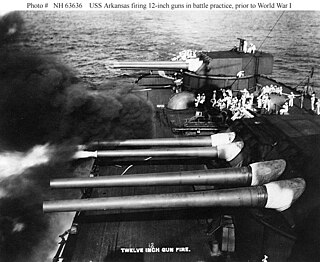
The 12"/50 caliber Mark 7 gun was a United States Navy's naval gun that first entered service in 1912. Initially designed for use with the Wyoming class of dreadnought battleships, the Mark 7 also armed the Argentine Navy's Rivadavia-class battleships.


